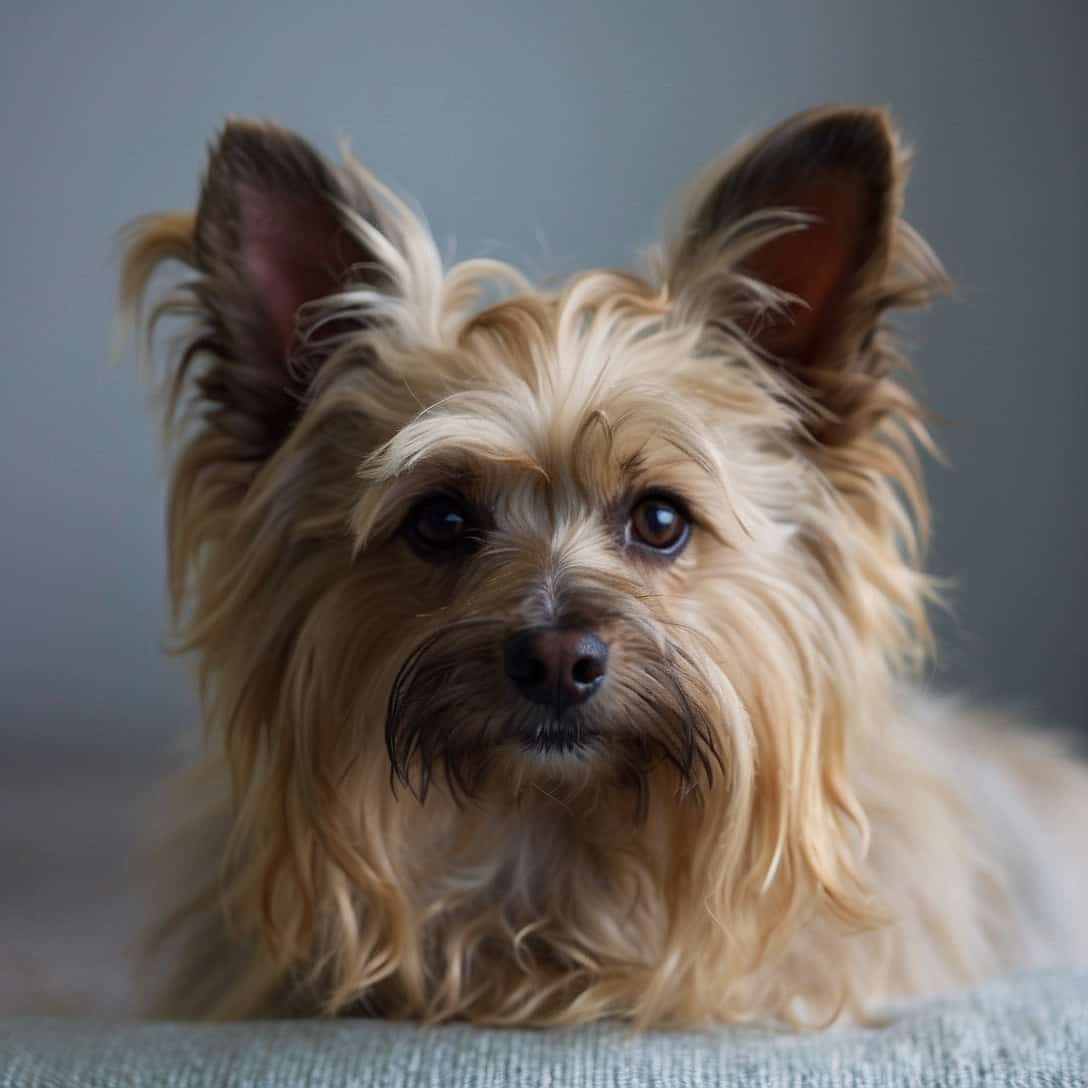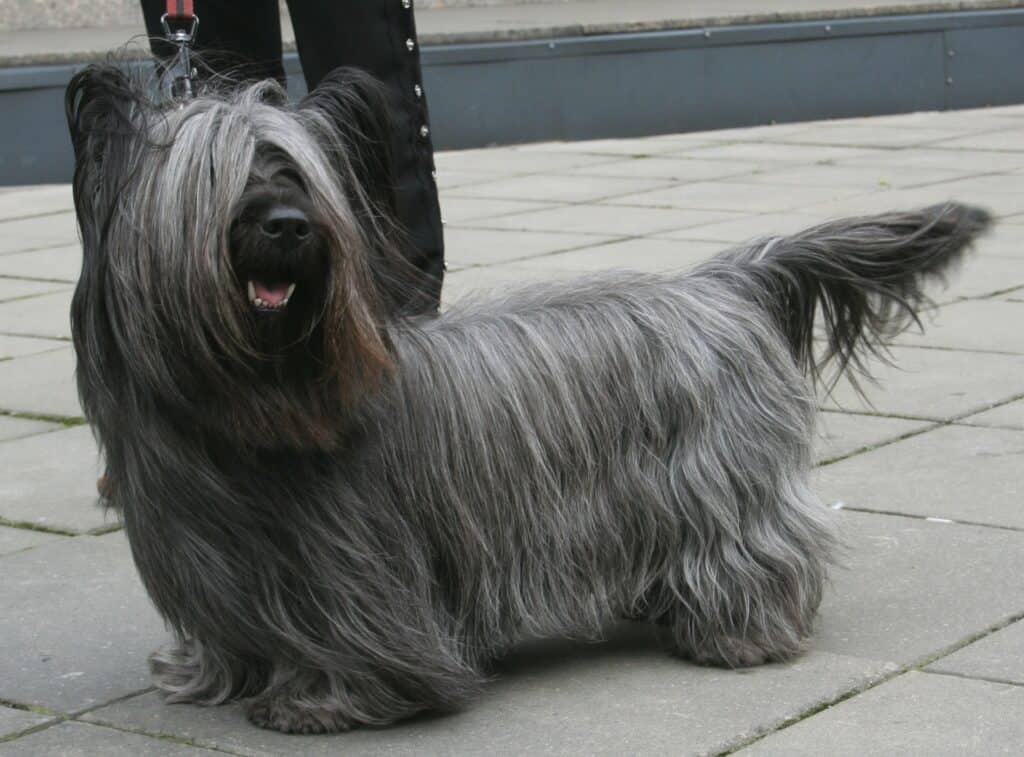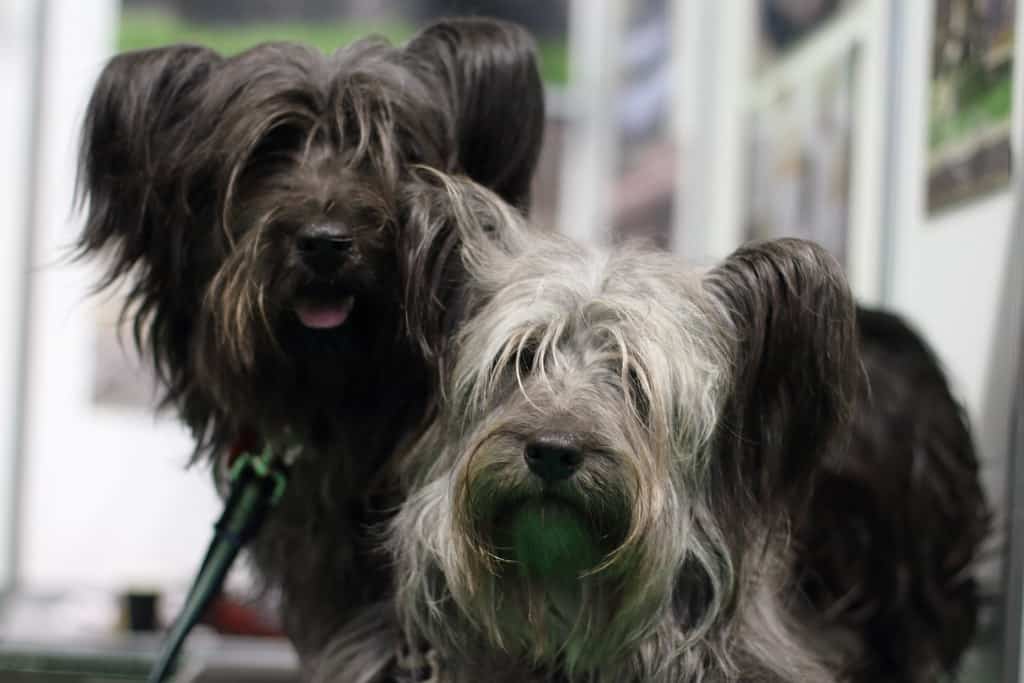Skye Terriers are known for their long, flowing coats and dignified presence. Explore their history, understand the care they require, and appreciate the regal and devoted nature that sets Skye Terriers apart.

| Category (Explanation) | Breed Information |
|---|---|
| Year of Breed Conception | Ancient |
| Country of Origin | Scotland |
| Weight (lbs & kg) (Male) | 35-45 lbs (16-20.5 kg) |
| Weight (lbs & kg) (Female) | 25-35 lbs (11.5-16 kg) |
| Coat Type | Long, straight, flat, and hard outer coat |
| Color Variations | Black, blue, gray, fawn, and cream |
| Shedding Level (Low, Moderate, High) | Low to Moderate |
| Height (cm & in) | 9-10 inches (23-25 cm) |
| Breed Size | Small to Medium |
| Trainability (Low, Moderate, High) | Moderate |
| Mental Needs (Low, Moderate, High) | Moderate |
| Intelligence Level (Low, Moderate, High) | Moderate |
| Energy Level (Low, Moderate, High) | Moderate |
| Agility (Low, Moderate, High) | Moderate |
| Loyalty (Low, Moderate, High) | Moderate |
| Playfulness (Low, Moderate, High) | Moderate |
| Exercise Needs | Regular exercise and mental stimulation |
| Guarding Proficiency (Low, Moderate, High) | Low |
| Sociability with Children (Low, Moderate, High) | High |
| Barking Level (Low, Moderate, High) | Moderate |
| Digging Tendency (Low, Moderate, High) | Low |
| Destructive Behavior (Low, Moderate, High) | Moderate |
| Drooling Level (Low, Moderate, High) | Low |
| Obedience Level (Low, Moderate, High) | Moderate |
| Apartment Friendly (Yes/No) | Yes, with sufficient exercise and mental stimulation |
| Inherent Prey Drive | Moderate |
| Physical Risk to Others (Low, Moderate, High) | Low |
| Travel Fatality Risk (Low, Moderate, High) | Low |
| Allergen Potential | Low |
| Health Concerns (List of Common Health Concerns) | Degenerative Disc Disease, Hypothyroidism |
| Average Life Expectancy (Life Expectancy in Years) | 10-12 years |
Woof Mastery is reader supported and our articles may contain affiliate links.
Instead of running third party ads that we have no control of we only use links from high-quality companies we are directly partnered with. Making use of these links come at no cost to you our reader, and in many cases have the extra benefit of discounted rates or sign up bonuses.
If you’re interested you can read more about our affiliate policy here.
We appreciate your support and always insure that the products and services we recommend are high-quality, helpful and relevant to the subject at hand!
The Skye Terrier, with its distinctive appearance and long history, originates from the Isle of Skye in Scotland. This breed’s history dates back several centuries, and it was originally developed to hunt and control vermin on the island. Skye Terriers were favored by Scottish royalty, including Queen Victoria, which contributed to their popularity in the 19th century.
Over the years, Skye Terriers gained recognition for their loyalty and unique double coat, which provides protection in various weather conditions. Despite their diminutive size, they were valued for their tenacity and bravery. Today, Skye Terriers continue to captivate with their charming appearance and historical significance as both working dogs and beloved companions.

Skye Terriers are known for their long, flowing coats and dignified presence. What makes them special is their long, flowing coats, dignified presence, and regal nature. Explore their history, understand the care they require, and appreciate the regal and devoted nature that sets Skye Terriers apart. Skye Terriers are special for their dignified appearance and devoted personality, adding elegance and loyalty to their owners’ lives.
The Skye Terrier’s traditional role can be traced to its heritage in Scotland’s Isle of Skye. These terriers were primarily used for hunting small game, such as otters, foxes, and badgers. Their long, flowing coat, along with their dignified presence, made them effective hunters in the Scottish landscape. Skye Terriers were valued for their determination, loyalty, and regal demeanor. Today, they continue to carry the legacy of their hunting roots while being beloved companions.
Skye Terriers are known for their long, flowing coats and dignified presence. They are characterized by their dignified and regal nature. These terriers can be loving and make delightful companions. They are known for their regal presence and require training and socialization to ensure they are well-behaved and dignified family pets.
Skye Terriers are known for their long, flowing coats and dignified presence. They are typically affectionate and regal dogs. While they can be loving with their families, they may exhibit some terrier independence. Training and socialization are crucial to ensure they develop into well-adjusted pets. Their loyalty and unique appearance make them stand out among terrier breeds.
Skye Terriers are known for their long, flowing coats and dignified presence. They have a well-balanced, sturdy build with a moderate length body. Their head is long, with a distinct stop, and they have dark eyes that convey an alert and intelligent expression. Skye Terriers have small, erect ears that stand slightly apart, and their tail is carried high, often beautifully plumed. Their double coat consists of a soft, dense undercoat and a straight, flat-lying topcoat. They are most commonly seen in shades of blue, black, gray, or fawn.
Skye Terriers usually have a long, flowing coat that comes in shades of blue, black, gray, or fawn. The coat color can vary, but these shades are commonly seen in Skye Terriers. The undercoat is often softer, while the outer coat is straight and harsh.
Skye Terriers have a long, flowing coat that is typically shades of black, blue, gray, or fawn. Their coat is silky and luxurious, giving them a regal and dignified appearance.
Skye Terriers have a low shedding level. These dogs have a long, flowing double coat that requires regular grooming to prevent matting and tangling. While they shed minimally, brushing their coat several times a week helps remove loose hair and keeps the coat in good condition. The Skye Terrier’s unique coat requires special attention to prevent tangles, and regular grooming sessions also provide an opportunity to check for any skin issues or abnormalities. Overall, Skye Terriers are considered a breed with relatively low shedding, requiring dedicated grooming care.
Skye Terriers have a long, flowing double coat that requires regular grooming to prevent matting and tangling.
Brushing: Brush their coat several times a week to remove loose hair and prevent mats. Use a slicker brush or a comb suitable for their coat type.
Bathing: Bathe as needed, typically every few months, using a dog shampoo designed for long coats. Rinse thoroughly and dry completely.
Trimming: Regular trimming, especially around the feet and hindquarters, helps maintain their appearance. Consult a professional groomer for guidance.
Ears: Check and clean their ears regularly to prevent wax buildup or infections. Use a damp cotton ball or a veterinarian-recommended ear cleaning solution.
Nails: Keep their nails trimmed for good foot health.
Teeth: Brush their teeth regularly to prevent dental issues and bad breath.
Skye Terriers have a moderate activity level. These small terriers appreciate regular walks and playtime to keep them physically and mentally stimulated. While they are not overly hyperactive, they enjoy spending time with their owners and may engage in interactive games. Skye Terriers benefit from a balanced routine that includes both exercise and opportunities for mental engagement.
Skye Terriers are known for their intelligence, marked by problem-solving abilities, resilience, and a desire to please their owners. They are generally trainable and responsive to positive reinforcement training methods. Skye Terriers can learn various commands and tasks. Their resilience allows them to adapt to different living environments. Historically, they were skilled in roles such as hunting and guarding, showcasing social intelligence by forming strong bonds with their families. While they may not top the charts in terms of obedience, their intelligence makes them excellent companions and working dogs. Training, socialization, and mental stimulation contribute to their well-rounded and obedient nature.
Skye Terriers benefit from mental stimulation to prevent boredom. Engage them in activities like puzzle toys, interactive games, and obedience training to keep their minds active and alert.
Social Interaction: They enjoy the company of their family and need regular interaction. Loneliness can lead to anxiety, so provide companionship and attention.
Exercise: While they have moderate energy levels, regular exercise is important for their overall well-being. Daily walks and playtime contribute to their mental and physical health.
Enter The Woof Mastery

Before choosing a Skye Terrier, it’s essential to recognize their unique characteristics. Regular exercise and mental stimulation contribute to their well-being. Grooming their long, flowing coat is a significant commitment. Skye Terriers are known for their loyalty and independence, so early training and socialization are crucial. Prospective owners should be aware of potential health concerns and provide regular veterinary check-ups. A loving and patient environment is key to ensuring the happiness and well-rounded behavior of these dignified and devoted dogs.
Skye Terriers, with their distinctive appearance and friendly demeanor, generally pose a low risk to others. Proper socialization and training contribute to positive interactions. Responsible ownership, understanding individual temperament, and adherence to local regulations play crucial roles in ensuring a well-behaved Skye Terrier.
Skye Terriers can be good with children when properly socialized. Supervision is important during play, and positive reinforcement training helps ensure positive interactions. Teaching children how to approach and handle the dog contributes to a positive relationship.
Skye Terriers may have varying responses to water. Some individuals may enjoy swimming, while others may not be as comfortable. If you plan to introduce them to water, do so gradually and observe their comfort level. Always prioritize safety and use a canine life vest if needed, especially in situations where they may be at risk of fatigue.
Remember that Skye Terrier puppies, like all puppies, are eager to please and learn. Positive and consistent training practices will help them become well-behaved, obedient, and happy adult dogs. Building a strong and trusting bond with your puppy through training is a rewarding experience for both you and your canine companion.
Skye Terriers are generally not considered noisy dogs. While they may bark on occasion, excessive barking is not a common trait. Proper training, socialization, and providing mental and physical stimulation contribute to a well-behaved Skye Terrier.
Skye Terriers do well in homes with individuals or families who can meet their exercise needs. They are adaptable to apartment living, provided they receive daily walks and play sessions. A secure outdoor space is beneficial. Socialization is essential to prevent shyness or aloofness.
When traveling with Skye Terriers, prioritize their well-being with the following considerations:
By addressing these considerations, you ensure safe and stress-free travel for Skye Terriers.
Skye Terriers may be susceptible to specific health issues. While not all individuals will experience these concerns, it’s important for Skye Terrier owners to be aware of potential health problems and collaborate with veterinarians for their pets’ well-being. Common health concerns in Skye Terriers include:
Regular veterinary check-ups, a balanced diet, proper exercise, and responsible breeding practices can help mitigate some of these health concerns in Skye Terriers.
Proper nutrition is crucial for the health and well-being of Skye Terriers. Here are some nutritional habits and best practices to consider for this breed:
Breed-Specific Laws (BSL): Skye Terriers may be subject to breed-specific laws (BSL) in certain areas. These laws are often enacted at the local or municipal level and can vary widely from one jurisdiction to another.
Types of Restrictions: The specific restrictions imposed on Skye Terriers under BSL can include mandatory spaying/neutering, special licensing, liability insurance requirements, muzzling in public, and, in some cases, bans on ownership. The severity of these restrictions depends on local regulations.
Rationale for BSL: BSL is typically implemented based on concerns about public safety and perceived risks associated with specific breeds, often due to incidents involving dog attacks. While Skye Terriers are not inherently aggressive, they can be affected by BSL due to their physical resemblance to breeds that are sometimes included in these laws.
Controversy: It’s important to note that BSL is a controversial topic. Critics argue that it unfairly targets breeds rather than addressing individual dog behavior and that responsible ownership and training should be emphasized instead of breed-specific restrictions.
Local Regulations: To determine if there are breed-specific laws or restrictions regarding Skye Terriers in your area, you should check with your local animal control or government authorities. Be aware of and comply with any local regulations to ensure that you are in compliance with the law while owning a Skye Terrier.
Woof Mastery is reader supported and our articles may contain affiliate links.
Instead of running third party ads that we have no control of we only use links from high-quality companies we are directly partnered with. Making use of these links come at no cost to you our reader, and in many cases have the extra benefit of discounted rates or sign up bonuses.
If you’re interested you can read more about our affiliate policy here.
We appreciate your support and always insure that the products and services we recommend are high-quality, helpful and relevant to the subject at hand!
Myth 1: Skye Terriers are High-Maintenance Grooming Dogs
Myth 2: They are Not Good with Children
Myth 3: Skye Terriers are Aggressive
Myth 4: They Need a Lot of Exercise
Myth 5: Skye Terriers are Not Trainable
Myth 6: They Don’t Get Along with Other Pets
Myth 7: All Skye Terriers Look the Same
Myth 8: They are Not Good Watchdogs
Myth 9: They Don’t Need Socialization
Myth 10: Skye Terriers are Only Suitable for Experienced Owners
These myths emphasize the importance of accurate information and responsible ownership to ensure Skye Terriers are well-cared-for and understood as individuals with unique personalities.
Famous Skye Terrier owners include:
The Skye Terrier holds cultural significance as a breed with a rich history and distinctive appearance. Skyes have been associated with Scottish royalty and have made appearances in literature and art. Their long, flowing coat and dignified presence contribute to their recognition as a symbol of loyalty and elegance. Skye Terriers have left an imprint in cultural narratives, both as loyal companions and as symbols of grace.
The Skye Terrier, known for its long, flowing coat, gained popularity in the 19th century. While there may not be a single most famous historical owner, Skye Terriers were favored for their unique appearance and loyalty.
Skye Terriers, known for their long coat and dignified appearance, face challenges that include:
The Skye Terrier, known for its distinctive long coat and upright ears, is believed to have been developed through a combination of terrier breeds. The contributing breeds include:
Skye Terriers, with their distinctive appearance and dignified personality, make charismatic family companions. Known for their loyalty and affectionate nature, they form strong bonds with their owners. Their long, flowing coat and elegant profile add to their charm. Skye Terriers thrive on interaction and engage actively in play. With proper training and socialization, they become devoted members of the family, bringing grace and a touch of sophistication to the household.